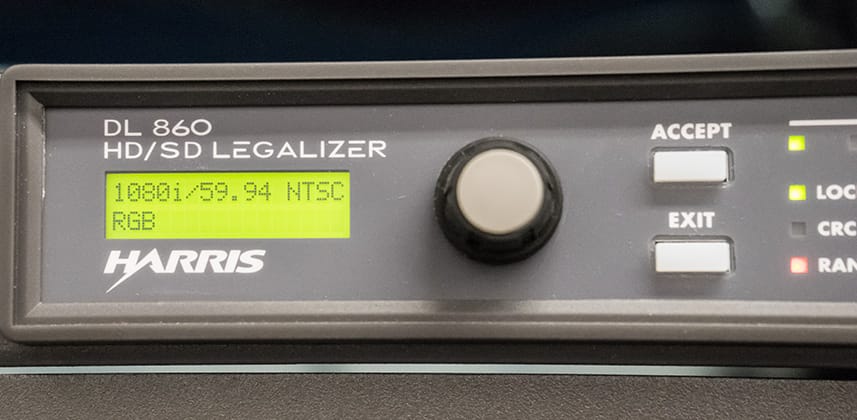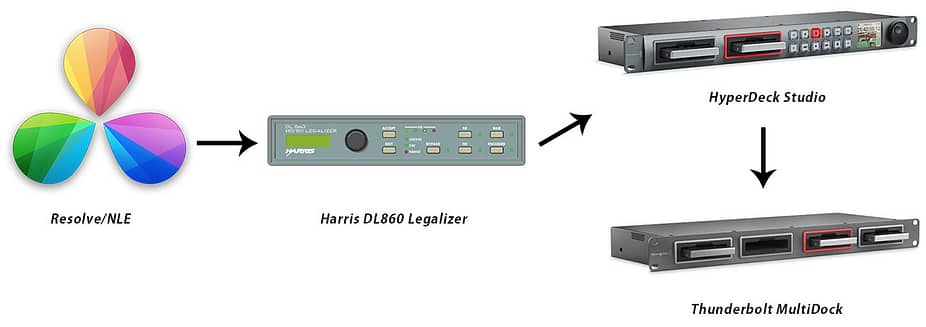| Series |
|---|
June 2018 UPDATE: If you’re delivering 1080 HD to your clients or a broadcast/cable channel, this Insight is VERY relevant to you. But 4 years after this Insight was written UHD & 4K deliverables are becoming common deliverables – and a hardware legalizer such as the DL860 can’t handle those signals. So you’re going to have to rely on software-based solutions. Just an FYI.
Part 3: Legalization Series
Because Software Legalization Can Only Get You So Far
Yep, I’m hijacking Patrick’s series on legalizing video (Patrick says: Go, Robbie, GO!) to agree that when it comes to delivering a legal video signal that will pass QC with confidence (at least for video levels) in a broadcast workflow there is really only one choice – Hardware Legalization.
In this series, Patrick has explored software legalization in Adobe SpeedGrade CC and Premiere Pro CC, and I know he will continue to show you software legalization tools in other apps and plugins. But, in this Insight, I want to share with you one of my most trusted tools for delivering content for broadcast – The Harris DL860 hardware legalizer.
What Is Legal Video?
Before we jump in, let’s revisit one thing. What does it mean to have legal video?
Every distributor or broadcaster is going to have different “rules” for how the video and audio signal in a deliverable should behave. These rules cover everything from slates to audio track layouts to areas of the image where no graphics are allowed to appear. For us colorists, the rules that matter most are:
- Maximum and minimum luma values
- Maximum saturation
- Encoded composite levels
- RGB gamut
While I’ll share with you a little later in this Insight my settings for the DL860, I want to stress that it’s VITAL that you obtain specs from the broadcaster/distributor you’re delivering to for what they consider to be legal. Then, make sure you understand the values requested, and if you don’t – ask the broadcaster for clarification.
Once you understand the specific values they request, you’re ready to set up your Hardware Legalizer.
What Is A Hardware Legalizer?
You’ve graded a project and paid extra attention to your levels – making sure that shot-by-shot your luma levels are good, and that your shots aren’t over-saturated. If you’re really diligent, you looked at your RGB parade or RGB gamut scope and made sure things were in order there too, perhaps doing a legalizing / limiting pass on the entire timeline.
Next, you apply a legalization filter or effect on the entire timeline (as Patrick discussed in the Premiere Pro CC article). After rendering you’re ready to go go go, right?
Not me.
While I think in many cases software legalization does a good job, ultimately for mission-critical work I choose to always go with a hardware legalizer. Here’s why:
- Software legalization is slow! Ever used a broadcast safe filter in an NLE? Yep, you know what I’m talking about! Hardware legalization works in real-time.
- Software legalization doesn’t catch everything. Not that a hardware legalizer is 100% perfect, but I’ve found that software legalization tools let a lot slip through most notably illegal RGB Gamut values. Hardware legalizers that I’ve worked with are exceptional at either clamping levels or rolling off in a nice way.
- Built-in software legalization tools seldom have a ton of configurability. I always want to have complete control over how I’m tweaking the signal. Hardware legalization devices like the DL860 offer a ton of configurability—even when compared to Premiere’s Video Limiter, which offers a decent amount of configuration options.
The Hardware Legalizer Challenge (and Reward)
Hardware legalizers have one pitfall that makes ownership of these devices a challenge – price.
With list prices anywhere from $5000 – $7500 the solo operator or small shop will find probably find that price tag simply too much to swallow.
Years ago, I felt that software legalizers should allow me to legalize with precision and that it was silly to spend a ton of money on a hardware unit. I now sing a different tune.
After DOZENS of times getting shows kicked back for various infractions with the signal it dawned on me that time is money. I made the decision to invest in the Harris DL860 because in the long run I knew it would actually save me money for the volume of broadcast work I do.
I can honestly say that in the past 4 years since I integrated the DL860 into my delivery pipeline (and used it on literally hundreds of episodes that were subject to Q.C.) I’ve only had 1 show kicked back for illegal levels and that was because of operator error (me). I missed a shot that was so exceptionally illegal that the legalizer could only make it slightly less illegal!
With that said, I do want to reiterate that while a hardware legalizer does a MUCH better job than a software solution its not bombproof. Don’t expect to never have problems. As I said, feeding a legalizer an extremely illegal shot might not make that shot perfectly legal, especially at default settings.
Soon after getting my DL860 it was obvious I needed to configure it – but you’d be shocked how hard the configuration information is to come by. When I asked friends at larger facilities if they would mind sharing – both colorists & engineers – I was told that their settings were sensitive information that couldn’t be shared!
In this Insight, my goal is to break down our industry’s information blockade on configuring a DL860! Hopefully, you’ll find the info in this article (and video) useful.
Integrating A Hardware Legalizer Into A Tapeless Workflow
You might be thinking to yourself:
[blockquote]OK Robbie, hardware legalizers are nice, but I don’t output to tape. How can I use a hardware legalizer in a tapeless environment?[/blockquote]
I asked myself that very question prior to investing in my DL860. The fact is we hardly go back to videotape anymore, instead, we’re delivering LTO tapes or SSD drives.
Because a hardware legalizer is a video device (HD-SDI) you can’t simply pass a file to it and have it do its thing. Instead, you must integrate it into a video/audio signal path via SD/HD-SDI and to make that work, and get a tapeless file, you need have a hard disk recorder.
Here is an illustration of how I route my projects thru a hardware legalizer (note: there is patching that is happening my machine room):
To use the legalizer in my studio here is what I do:
- From Resolve, Premiere, Pro or whatever video tool I’m using, I patch that output into the input of the DL860
- The primary output of the DL860 feeds a HyperDeck Studio where I can record uncompressed, any flavor of ProRes or DNXHD (mxf or QuickTime). I can also patch additional DL860 outputs so I could layback to an HDCAM SR tape deck while at the same time recording a legalized ProRes file.
- After the recording is done (a real-time process) I pull the SSD that the show got recorded on and plug that in to a Blackmagic Thunderbolt Multi-dock where I can quickly transfer the footage back to my machine to finish the project or deliver with other materials on a client supplied drive.
There are variations on this workflow – some people use another system to perform a live capture but I’ve found this workflow to work well with the projects I work on.
Taking A Look At The Harris DL860
Before we jump into the particulars of configuring the DL860 I thought it’d be a good idea to jump into my machine room and actually take a peek at the box.
While some of you may have hands-on experience with a hardware legalizer, some of you may not, so in this short movie, I want to give you an overview of this popular hardware legalizer including discussing its size and shape, front panel controls and rear connections.
After checking out the video be sure to continue reading the rest of this Insight for specific details on configuring and using the DL860.
Member Content
Sorry... the rest of this content is for members only. You'll need to login or Join Now to continue (we hope you do!).
Need more information about our memberships? Click to learn more.
Membership optionsMember Login




